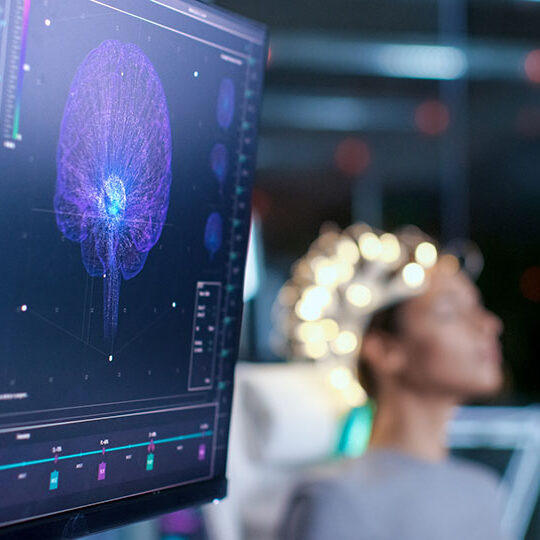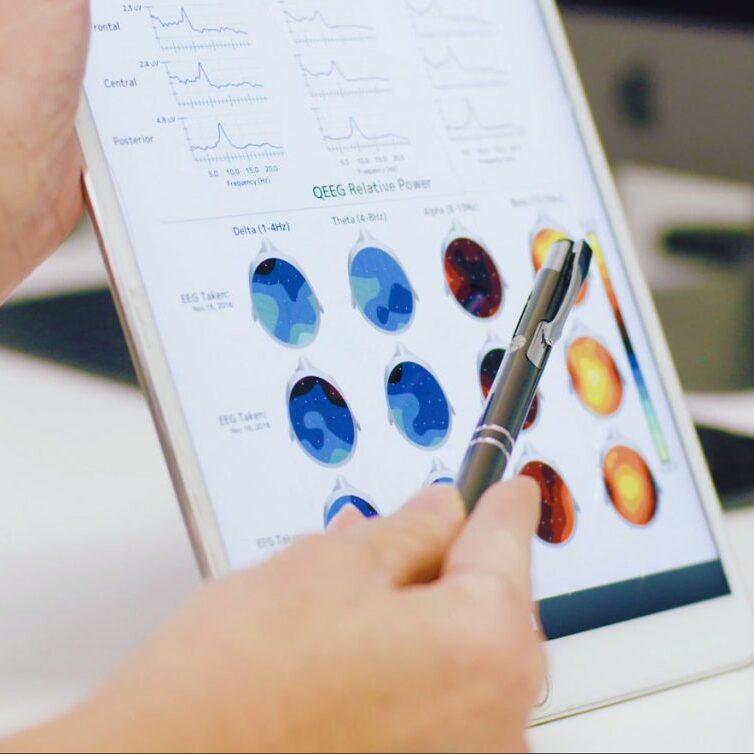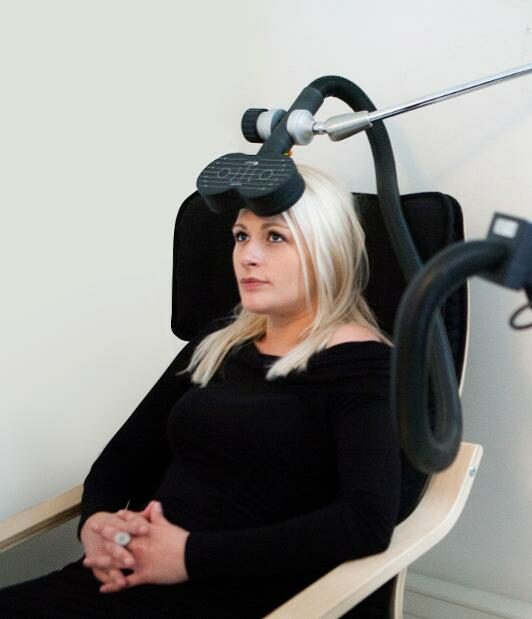
Frequently Asked Questions (FAQs) About MeRT at MindALGN







General Questions About MeRT
What is MeRT?
Magnetic e-Resonance Therapy (MeRT) is an emerging, noninvasive, and drug-free treatment designed to improve brain function by stimulating specific areas with magnetic waves. MeRT combines several technologies, including repetitive transcranial magnetic stimulation (rTMS), quantitative electroencephalogram (qEEG), and electrocardiogram (EKG), to create a personalized treatment plan based on your unique brainwave patterns.
How is MeRT different from traditional TMS?
While traditional TMS delivers a one-size-fits-all stimulation to one specific brain region, we fully customize MeRT for each patient. We tailor the treatment location, frequency, and intensity to your brain’s specific needs, as identified through qEEG and EKG results. This individualized approach allows for more precise targeting and potentially greater effectiveness.
How is MeRT different from other brain stimulation therapies?
MeRT is distinct from other brain stimulation therapies like Electroconvulsive Therapy (ECT), Vagus Nerve Stimulation (VNS), and Deep Brain Stimulation (DBS) in several ways:
- VNS and DBS both require surgical implantation of devices (a pulse generator for VNS and electrodes in the brain for DBS), making them invasive procedures. MeRT is entirely non-invasive and does not involve any surgical procedures.
- ECT requires anesthesia and induces controlled seizures, typically used for severe mental illnesses. MeRT is non-invasive, does not require anesthesia, and uses gentle magnetic pulses.
What research supports the use of MeRT for brain treatment?
Many scientific studies back MeRT, including research in prestigious journals. While it is FDA-cleared for treating Major Depressive Disorder (MDD) and Obsessive-Compulsive Disorder (OCD), ongoing research is exploring its effectiveness for other conditions such as autism, PTSD, and cognitive decline. Studies show that by customizing treatment to each patient’s brain patterns, MeRT can improve brain connectivity and function.
Is MeRT FDA-approved?
The equipment used for MeRT is FDA-cleared to treat Major Depressive Disorder (MDD) and Obsessive-Compulsive Disorder (OCD). We use MeRT off-label for other conditions, such as autism, PTSD, and cognitive decline; it has shown promising results in these areas based on emerging research.
Questions About MeRT Treatment Sessions
How does MeRT work?
MeRT uses individualized brain wave analysis to determine which areas of the brain are not functioning or communicating optimally. By stimulating these regions, MeRT seeks to restore healthy brainwave activity and improve overall function. This approach is particularly effective for patients dealing with conditions such as depression, anxiety, and cognitive decline.
What conditions can MeRT treat?
MeRT has shown positive results in treating a wide range of neurological and cognitive conditions, including:
- Autism Spectrum Disorder (ASD)
- Depression (including treatment-resistant depression)
- Post-Traumatic Stress Disorder (PTSD)
- Anxiety
- Traumatic Brain Injury (TBI)
- Cognitive decline and dementia
- Obsessive Compulsive Disorder (OCD)
- Attention Deficit Hyperactivity Disorder (ADHD)
What is involved in a typical MeRT session?
Each MeRT session typically lasts between 30 and 45 minutes. You will sit comfortably while a neurotechnician places a magnetic coil near your scalp to deliver magnetic pulses. Each pulse lasts 6-8 seconds, followed by a brief rest. The procedure is painless, and people experience only a mild tapping sensation.
Can I continue my regular activities, like driving and working, during the MeRT treatment period?
Yes, you can continue regular activities during the treatment period. However, you must be able to stay in Bethesda or the surrounding area for each two-week treatment period.
How many sessions will I need?
Treatment typically involves daily sessions five days a week for 4-6 weeks. Each patient’s protocol may vary depending on the severity of the condition and individual response. We perform additional qEEGs regularly to monitor progress and adjust the treatment plan as needed.
After-treatment Questions
How soon can I expect to see results?
Many patients begin to notice changes within the first two weeks of treatment. However, since every brain is unique, response times can vary. Regular progress assessments, including follow-up qEEG scans, ensure we adjust the treatment to maximize effectiveness.
Are there any side effects?
Side effects with MeRT are rare and generally mild. The most commonly reported side effect is a mild tension headache at the stimulation site, which usually subsides within a few hours and responds well to over-the-counter pain medication. Other potential side effects include agitation, euphoria, or hyperactivity. The risk of seizures is very low due to careful control of the stimulation intensity.
What can I expect after completing MeRT treatment?
After completing the recommended course of treatment, many patients experience long-lasting improvements. Some may require occasional maintenance sessions to sustain their progress. Each person’s results vary, but many report improved mood, cognitive clarity, and a better quality of life.
Can I get MeRT treatment alongside other therapies?
Yes, we often use MeRT in combination with other treatments, such as psychotherapy or medication. By improving brain function, MeRT can enhance the effectiveness of additional therapies.
Additional Questions
What qualifications does your clinic have?
At MindALGN, licensed neurosurgeons and physicians oversee all MeRT treatment parameters. Our clinicians have extensive experience with brain stimulation therapies and are dedicated to providing the highest level of care. The neuro-technicians administering the treatment are thoroughly trained in MeRT protocols, ensuring they conduct each session safely and effectively. Read more about our team here.
Does insurance cover MeRT?
MeRT treatment is FDA-approved for certain conditions, such as depression and OCD. Coverage for other conditions may vary by provider. MindALGN offers out-of-network billing support, and we can provide documentation to help you seek reimbursement from your insurance provider. A consultation with our team will clarify coverage options based on your insurance plan.
How do I know if I’m a candidate for MeRT?
Suitability for MeRT is determined through a thorough initial consultation, which includes a qEEG and EKG to assess brain function. Patients with certain medical devices (such as pacemakers or cochlear implants) or conditions (such as seizure disorders) may not be eligible for MeRT.
How do I schedule a consultation?
To find out if MeRT is right for you, schedule a complimentary consultation with our New Patient Coordinator. During this consultation, you can discuss your symptoms, learn about the process, and ask any questions you may have.
Talk to Our New Patient Coordinator for More Information
Our New Patient Coordinator is here Monday to Friday and can help you with any questions you may have. There is no obligation to call and talk to her. She is happy to explain more about MeRT, our protocols for treatment, fees, insurance questions, and more.
If you are interested in exploring treatment further at any point, she can also schedule you for the next steps: a qEEG (non-invasive brain scan) followed by a consultation several days later.
Once the qEEG is done, the doctors and scientists at Wave Neuro will carefully study and analyze your testing and symptoms. Our clinician will then discuss the results and show you what is happening neurologically.
We can then determine if you may benefit from MeRT treatment, and you can decide if you would like to move forward.

Things Can Get Better
We hope you will consider getting more information, so that you can make an informed decision if MeRT may benefit you or your loved one. With years of successful treatments for a wide range of neurological conditions, we have witnessed improved quality of life for so many!
Or fill in the form below, and we will contact you.
Schedule Your Free Consultation
For more information or to speak with our Client Care Coordinator, please fill out the information below.
